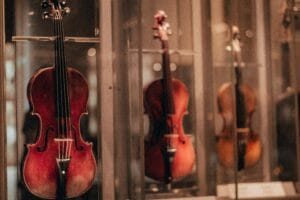“What’s the difference between a violin and a fiddle?” You’ll probably recognize this as the start of many jokes, but it’s also a legitimate question.
There are tons of misconceptions out there, so let’s clear some things up right now:
- Violins and fiddles are NOT differently sized
- Violins are NOT necessarily more expensive than fiddles
- Fiddles are NOT more durable than violins
 So what is the difference between a violin and a fiddle? It’s a trick question, because they’re the same instrument. However, even though the structure of the instrument itself is the same, there are still reasons you might refer to one instrument as a violin and another as a fiddle. Those reasons include:
So what is the difference between a violin and a fiddle? It’s a trick question, because they’re the same instrument. However, even though the structure of the instrument itself is the same, there are still reasons you might refer to one instrument as a violin and another as a fiddle. Those reasons include:
- The style of music played on the instrument
- The instrument’s “set-up” (its strings, fine tuners, bridge height, and other changeable features of the instrument)
- The performance context in which the instrument is used
Let’s take a moment to examine these differences more closely.
Stylistic differences between violin and fiddle
The term “violin” is used to refer to various genres of classical music. You’ll also hear people refer to “jazz violin.” When you attend a symphony performance or listen to a chamber orchestra, you’re listening to violin music.
In contrast, the term “fiddle” is usually used to talk about genres of traditional folk music that have been passed down aurally. Fiddle music is what people danced to before recorded music, so you may notice that fiddle music often features a strong, danceable rhythmic groove. Genres under the umbrella of fiddling include Bluegrass, Texas-style, Irish, Cape Breton, Western Swing, old-time, and many more.
Set-up differences between violins and fiddles
Musicians’ preferences differ, so you’ll find many variations in how violins and fiddles are set up. However, there are some common differences in set-up:
- Violinists often have only one fine tuner on their instrument’s tailpiece (the E string tuner) and use their pegs to make fine tuning adjustments on the other strings. Most fiddlers have four fine tuners so that they only need to use the pegs to make large tuning adjustments.
- Fiddlers often have a slightly flatter slope to their bridge so that it’s easier to play two strings at once, a key feature of many fiddle genres.
- Fiddlers and violinists often prefer to use different types of strings. Fiddlers will often go for louder, brighter-sounding strings to help their instruments cut through accompanying instruments while violinists will often choose a darker, more rounded sound to help their instrument blend with other instruments.
Different performance contexts for violin and fiddle
Because of the differences in genre and repertoire, violin and fiddle music are played in quite different settings. You’ll hear violins in orchestras, movie soundtracks, recitals, string sections within pop music, classical quartets, and more. Fiddle music is what you’ll hear when you go to a square dance, fiddle contest, casual jam session, barn dance, or the Grand Ole Opry. These are simply different settings for different styles.
Does this answer your questions about the difference between a violin and a fiddle? If you want to learn more about fiddling, check out our blog posts on fiddling repertoire, learning by ear, fiddle technique, jam sessions, and more.
